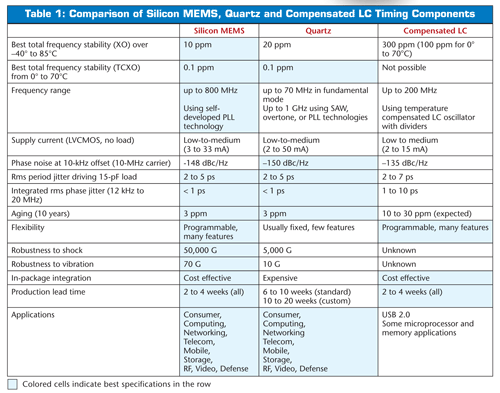Silicon-based timing devices compete with quartz
What you need to know in order to select a clock device
BY PIYUSH SEVALIA
Vice President of Marketing
and
SASSAN TABATABAEI
Director of Strategic Applications
SiTime
www.sitime.com
Timing components are extremely important in electronics. The clock signal in every digital electronic system is its heartbeat, to which all signals in the system are synchronized. Because of its importance, designers pay particular attention to the precision and reliability of this clock signal.
When selecting a clock device, engineers focus on key parameters such as frequency stability (how the frequency varies with temperature), accuracy (closeness to target frequency over voltage, stress, shock, vibration, time) and jitter (variation in the actual clock edges from their ideal location).

Fig. 1: Silicon MEMS timing components in standard plastic packages.
Quartz timing components, in spite of their limitations, have been extensively used
The electronics industry has been using timing references that are based on quartz (also known as crystals) for the past few decades. Depending on the type of the system, two kinds of components are used – a quartz crystal resonator, which is a mechanical vibrating element, and a quartz crystal oscillator, which marries a resonator with an electrical circuit to output a clock signal.
A quartz crystal-based reference is commonly used as the timing reference because it performs well on the key technical parameters listed above. However, for a quartz crystal device to perform well, it has to be manufactured very painstakingly, which compromises on features and supply-chain flexibility. Because of the lack of alternate timing components, the electronics industry has accepted these limitations, such as:
a. Using only a few standardized frequencies because they are easier and more cost-effective to manufacture.
b. Using additional devices with extra cost and board area, such as voltage-level translators, buffers and spread spectrum clock generators because this functionality is not integrated or available from quartz devices.
c. Using expensive ceramic packaging that is only available from a few suppliers, and has leakage or availability issues.
d. Placing production orders for timing components 6 – 16 weeks in advance, to ensure that manufacturing of a complex system is not held up by availability issues on timing components.
Semiconductor-based timing components address quartz limitations
Recently, semiconductor manufacturers have begun to offer reference timing components which do not use quartz technology, and address the quartz limitations without compromising performance, flexibility, features, and cost. There are primarily two approaches to implementing all-silicon timing references that can be integrated inside plastic packages:
a. Using micro-electro-mechanical systems (MEMS) technology, where the mechanical resonator is manufactured and vacuum sealed in Silicon. In this case, a high-Q MEMS resonator die is bonded together with an analog circuit inside a standard semiconductor plastic package.
b. Using compensated LC oscillators (with no moving components), with low-Q in an analog circuit, which is then packaged into standard semiconductor plastic package.
Table 1 compares MEMS-based oscillators, quartz crystal oscillators, and LC oscillators. Cells highlighted in blue indicate the best specifications in that row.

As can be seen from the table, both Silicon MEMS and Quartz timing components offer very high performance and can be used in virtually any application. While quartz timing components are still used extensively, Silicon MEMS timing solutions have made significant inroads.
The semiconductor-based Silicon MEMS and Compensated LC timing components both offer the benefits of flexibility, features, supply chain simplification, lower cost, and integration over quartz-based timing products. However, because of their lower performance, Compensated LC timing components cannot be as widely used as Silicon MEMS timing components. To-date, most of the applications for Compensated LC have been in microprocessor, memory and USB 2.0 clocking.
With the introduction of semiconductor-based timing solutions, the timing components industry is undergoing significant changes. The increased competition will only result in more benefits for electronics manufacturers and consumers. ■
Advertisement
Learn more about SiTime





